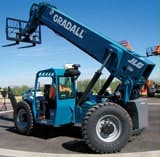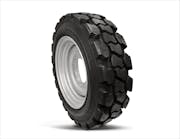The Gradall 544D10-55 is one of two machines — the other being Lull 1044C-54 — with a truly unique design. Its blue exterior makes it easy to pick out of a crowd, but that is not the only thing that makes the Gradall telehandler, built by JLG Industries, McConnellsburg, Pa., distinctive. Its axle configuration features 90° pivot-steering.
The rear-pivot design keeps the outside turning radius at only 178 inches, which is less than the overall length of the machine — a major selling point. Only the recent advent of tighter 55° turning axles on competitive machines has allowed larger, longer wheel-based, four-wheel steer machines to compete with this capability. However, a more complex design, more service points, and possibly more wear-point potential are the trade-off that comes with the ability to pivot 90°.
Independent hydraulic drive motors coupled with Fairfield torque hubs power each rear wheel. The front axle is a rigid, limited slip design supplied by Carraro. On the floorboard of the cab, a separate pedal is used for differential axle lock. When depressed, in conjunction with the accelerator, this traction lock splits the oil flow between the front and rear axles. A separate set of relief valves protects the rear-drive motors from any pressure spikes.
The Rexroth-supplied hydrostatic transmission is sensitive to engine rpm. Maximum operating pressure is 6,300 psi, and the transmission comes online when the 125-hp John Deere 4045HF275 Turbo engine is turning at about 1,100 rpm. Another feature of the hydrostatic drive is the ability to de-stroke the pump, which is accomplished by depressing the brake pedal halfway. De-stroking the pump allows the operator to inch, or feather, the drive and/or brake with the use of one pedal. It also allows the drive speed to be regulated independently from the engine speed.
Because all controls are pilot-operated, there are no electronics involved in the direct operation of the machine. On a standard unit, controls are grouped on the right side of the steering column. An optional left-hand fork tilt, frame-leveling control is a very popular option on the West Coast.
The 544D10-55 has a fairly long wheelbase and a very low center of gravity, which translates into greater lifting capabilities and added stability when carrying a load over rough terrain. The machine lifts 4,000 pounds to the maximum 55-foot lift height without the use of outriggers; however, outriggers are required to take 3,000 pounds to full horizontal reach of 42 feet. Primarily a pick-and-carry machine, the unit offers great visibility to the side and rear when a load is in the carry position. Good visibility is due in part to the low engine mount and boom support structure design. While this particular mid-mount engine is not the easiest of the group to service, most critical service points are accessible.
Other points: Tires have hydro-fill for stability. The hydraulic oil filler is located right next to the fuel filler, so keep a lock on the cap. JLG has gone to great lengths to make its four-section boom assembly easy to service and repair. If service is required, the hydraulic sub-assembly at the rear is removable in 45 minutes. Axles feature 90° pivot-steering.
 The Gradall 544D10-55 is one of two machines — the other being Lull 1044C-54 — with a truly unique design. Its blue exterior makes it easy to pick out of a crowd, but that is not the only thing that makes the Gradall telehandler, built by JLG Industries, McConnellsburg, Pa., distinctive. Its axle configuration features 90° pivot-steering.
The Gradall 544D10-55 is one of two machines — the other being Lull 1044C-54 — with a truly unique design. Its blue exterior makes it easy to pick out of a crowd, but that is not the only thing that makes the Gradall telehandler, built by JLG Industries, McConnellsburg, Pa., distinctive. Its axle configuration features 90° pivot-steering.




